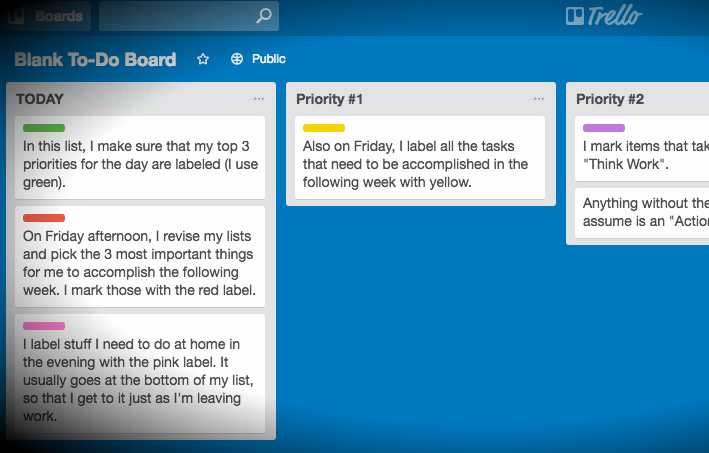Ah, the to-do list.
Lately, I’ve had dozens of calls from high-achievers (a Head of School, a university athletic coach, a tech industry Chief Marketing Officer) asking me for specific instructions for keeping a more effective to-do list. Ineffective task lists trigger overwhelm, and these folks were suffering. They’d look down at their list and instinctively think: There is no way I can get all this done today.
Great to-do lists, on the other hand, do several things (besides provide you with that feeling of accomplishment when you cross something off of it):
- They allow you to focus on your highest priorities and your most important work without having to decide what, exactly, that is in any given moment.
- They externalize information so that you don’t need to remember it, freeing up space and energy in your brain. The key here is having a list that keeps your brain from interrupting you with “reminders” that you need to, say, pick up kitty litter on the way home from work. (Note: Just writing something down on a list isn’t enough to silence the reminders that come from your unconscious mind.)
- They promote a state of deep focus by providing cues as to where you are in your workflow.
Below are the five steps to transform a long, overwhelming list of things into a high performing task-list. A note about format: You’ll probably have to give up your pen and paper list for this one. Not forever, though–just know that you’ll move through the steps below much more quickly if you use an online tool. I’ve used and loved to-doist in the past; I’m currently using Trello because of the way that it integrates with my team’s lists. If you’d like to use Trello, you can copy one of my blank to-do list boards here. (Instructions for how are here.)
Step 1: Decide on your Top Five priorities. Not just at work, but in your life.
Time management guru Peter Bregman, author of 18 Minutes: Find Your Focus, Master Distraction, and Get the Right Things Done, advises his clients (mostly high-profile business leaders) to pick their top five priorities and then spend 95 percent of their time doing only those activities, saying “no” to virtually everything else. This idea made a lasting impression on me when I first heard him talk about it because I was so convinced that there was no way that I could spend 95 percent of my time doing things that fell into my top priorities. I was too busy just making sure the trains ran on time!
But it turns out that now I do spend 95 percent of my time on my most important priorities. To give you an idea of how this worked for me, here are my top five priorities this year, in order of importance:
(1) Maintain my own health and happiness.
(2) Nurture my family, home, and closest friendships.
(3) Grow my online class offerings.
(4) Coach and teach both individuals and groups.
(5) Give back to our community.
If your to-do list is going to help you focus on your most important work, you’ll need to decide now what your most important work is, and I don’t just mean at a paying job. What brings meaning and fulfillment to your life? What, when neglected, causes your world to unravel? (Note to parents: This priority is probably your own self-care.) I created a list in Trello with each priority, and then added an extra one for the “Other 5 percent.” You could also do this on pen and paper with Peter Bregman’s worksheet, here.
Step 2: Organize your tasks under these categories.
Now that you know what your priorities are, organize your tasks by priority. If a task doesn’t fall under a Top Five Priority, put it in the “Other 5 percent” column.
An aside about parenting tasks: People often ask me where things like making doctor’s appointments for kids go, if one of their priorities is to nurture their family. Here’s my rule of thumb: If it is something that a family member (or you, if it is a self-care item) will feel nurtured by, put it under a related priority. If it’s something that no one will notice (they’ll take it for granted, and it feels like a chore) then it’s a 5 percent item. I try to delegate as much of this type of work as possible; for example, even my youngest, who is 13 years old, is learning how to arrange her own schedule and make her own appointments. Teaching kids how to do this sort of stuff takes longer than doing it myself, and the error rate is ridiculous at first, but it moves the task back into the “nurturing” priority, and then off my list forever.
Step 3: Mark tasks that require focus as “Think Work” and quick tasks as “Action Items.”
What work do you save for when you have some quiet time? Or what could you do better/faster/smarter if only people would stop interrupting you? This type of work is what I call “Think Work.” (I label it purple on my Trello list). Everything else I consider an “action item” that I don’t need a big block of time and concentration to finish.
Step 4: Schedule time on your calendar for both things.
This is a critical step, so don’t skip it: Block off time everyday to do your Think Work and move through your Action Items one at a time in quick succession. You need to tell your brain WHEN you will do these things. Here’s why: Lingering to-do items tend to be low-level stressors for humans. Have you ever woken up worrying about an unfinished project, an email you forgot to send, or a meeting you didn’t have a chance to schedule?
Researchers used to think that this low-level worrying about unfinished tasks was our unconscious mind trying to help us get things done by reminding us of what we still needed to do, and that the reminders— or distracting thoughts and worries—would persist until the task was complete.
But now research shows that simply making a plan to deal with an unfinished task makes a huge difference in our ability to focus on other things; it’s hard to focus when your unconscious mind is constantly reminding you about other stuff you need to do. It’s not so much about knowing what needs to be done as it is about deciding when to do it. When we don’t know when we plan to do the things on our task lists, our thoughts will typically wander from our current task to our undone tasks. As it turns out, our unconscious isn’t nagging us to do that undone task right away but rather to make a plan for when we will get it done.
To handle this, you can either decide when you’ll do something on your list and put that on your calendar, or decide that you’ll handle something when you are doing your Think Work or Action Items. This is all, it seems, that our brain needs to let something go. (Remember, it’s not what, it’s when.)
Step 5: Strategically organize your to-do list both weekly and daily.
On Friday afternoons I spend 15 minutes organizing for the week ahead. I mark items I need to accomplish in the coming week, and then I mark the three most important things on that list, a strategy I learned from Chris Bailey, author of The Productivity Project. Pay attention to your “Other 5 percent” list; you can figure on spending about 45 minutes a day on tasks that don’t cut it as a Top-Five priority.
I also spend a little time organizing my list either before I leave work (for the next day) or first thing in the morning. By a little time, I mean less than five minutes, because I would lose a lot of time on this step if I let myself. (Planning is so much easier than doing for me.) Each day, I move items marked to do this week to a list labeled “TODAY”. (This is the time for pen-and-paper folks to return to a tidy hand-written list you’ll have by your side throughout the day.) I put tasks in the order that I’d like to accomplish them, grouping Think Work, Action Items, stuff I need to do at lunch or on break, and things to do when I get home.
Ordering your tasks is important: A key precursor to getting into “The Zone” is knowing where you are in your workflow. “That constant awareness of what is next is what keeps you focused,” Mihaly Csikszentmihalyi, author of Flow: The Psychology of Optimal Experience, told Entrepreneur magazine. “That’s where the engagement comes from.” So having a prioritized list of just the things that you’d like to accomplish today will allow you to note what you’ve just accomplished, what you hope to accomplish next, and what you’ll work on after that.
I hope this method for managing your tasks–and your time–allows you to accomplish more of what matters most to you. When we organize our tasks by what we value, we allow ourselves to start running our lives more by our heart than by our schedules, and this, writes fellow sociologist and master coach Martha Beck, “is the only method that is efficient enough to help us get everything done that we need to do.”
Let us know in the comments how it works for you!


